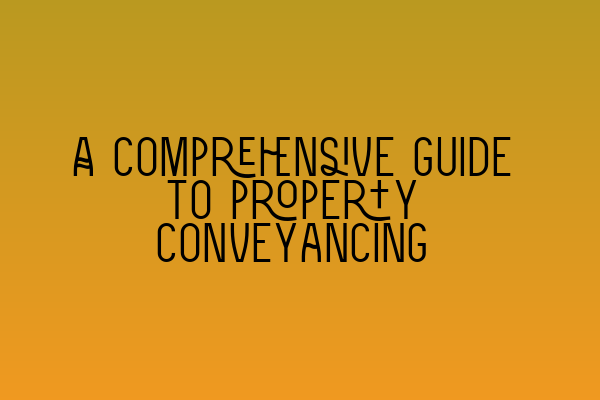A Comprehensive Guide to Property Conveyancing
Welcome to SQE Property Law & Land Law’s comprehensive guide to property conveyancing. Whether you are a buyer, seller, or a solicitor, understanding the conveyancing process is essential to ensure a smooth and successful property transaction. In this guide, we will take you through the key steps involved in property conveyancing, providing you with the knowledge and insights you need to navigate through this complex field.
1. Introduction to Conveyancing
Conveyancing is the legal process of transferring the ownership of a property from one party to another. It involves various legal, financial, and administrative tasks that need to be completed to ensure a valid and lawful transfer. These tasks include preparing and reviewing legal documents, conducting property searches, arranging survey reports, and handling the financial aspects of the transaction.
2. The Role of a Solicitor
One of the crucial aspects of property conveyancing is the involvement of a solicitor. A solicitor acts as your legal representative throughout the process, ensuring that all legal requirements are met, and protecting your interests. They handle the paperwork, communicate with the other party’s solicitor, and provide you with legal advice to help you make informed decisions.
If you are pursuing a career in property law, preparing for the SQE 1 exam is an important step. To help you in your preparation, check out these SQE 1 practice exam questions: [link to SQE 1 Practice Exam Questions]. Additionally, consider taking SQE 1 preparation courses to enhance your knowledge and improve your chances of success: [link to SQE 1 Preparation Courses].
3. Key Steps in the Conveyancing Process
a) Instruction and Preliminary Checks
The conveyancing process begins when a buyer instructs a solicitor to handle the transaction. The solicitor will conduct initial checks, including verifying the seller’s title, obtaining necessary documents, and confirming the buyer’s financial position. These checks establish the groundwork for the transaction.
b) Drafting and Reviewing Contracts
The next step involves drafting and reviewing the contract of sale. This legal document sets out the terms and conditions of the transaction, including the price, completion date, and any additional conditions. Both parties’ solicitors will negotiate and make necessary amendments until both sides are satisfied with the terms.
c) Searches and Enquiries
Performing property searches is essential to uncover any potential issues that may affect the property or the transaction. These searches include local authority searches, environmental searches, water and drainage searches, and more. Additionally, the buyer’s solicitor will raise enquiries to gather information about the property’s history, any ongoing disputes, or any other relevant matters.
For those preparing for the SQE 2 exam, consider exploring SQE 2 preparation courses that can help you grasp the legal intricacies of property law: [link to SQE 2 Preparation Courses].
d) Survey and Mortgage Arrangements
Before finalizing the transaction, it is important for the buyer to arrange for a survey of the property to identify any structural issues or defects. This information plays a crucial role in determining the value of the property and negotiating the final price. Simultaneously, the buyer needs to secure a mortgage or financing arrangement to fund the purchase.
e) Exchange of Contracts and Completion
Once all the necessary checks and arrangements are in place, the solicitors for both parties will exchange signed contracts, legally committing both parties to the transaction. At this stage, the buyer will pay a deposit, usually 10% of the property’s price. Completion takes place on the agreed completion date, at which point the remaining funds are transferred, and ownership of the property is officially transferred.
f) Post-Completion
After completion, the buyer’s solicitor handles post-completion tasks, which include registering the property with the Land Registry, paying stamp duty, and notifying relevant authorities of the change in ownership. These tasks are crucial to ensuring that the buyer’s ownership is legally recorded and protected.
To stay up-to-date on SRA SQE exam dates and relevant information, check out our article on SRA SQE Exam Dates: [link to SRA SQE Exam Dates].
4. Conclusion
Property conveyancing is a complex process with many intricate steps. Whether you are a buyer, seller, or a solicitor, being well-informed about the conveyancing process is crucial for a successful property transaction. By understanding the key steps involved and seeking professional guidance, you can navigate through the process with confidence and ensure a smooth experience.
If you found this guide helpful and are interested in exploring further resources, we recommend checking out our SQE 1 practice mocks FLK1 FLK2, which can provide invaluable practice and insights: [link to SQE 1 Practice Mocks FLK1 FLK2].
Remember, if you are pursuing a career in property law or are in need of legal advice for a property transaction, it is always best to consult with a qualified solicitor who specializes in property conveyancing. They have the expertise and experience to guide you through the process and ensure your interests are protected.
Disclaimer: This article is for informational purposes only and should not be considered as legal advice. Always consult with a qualified solicitor for professional advice tailored to your specific situation.
